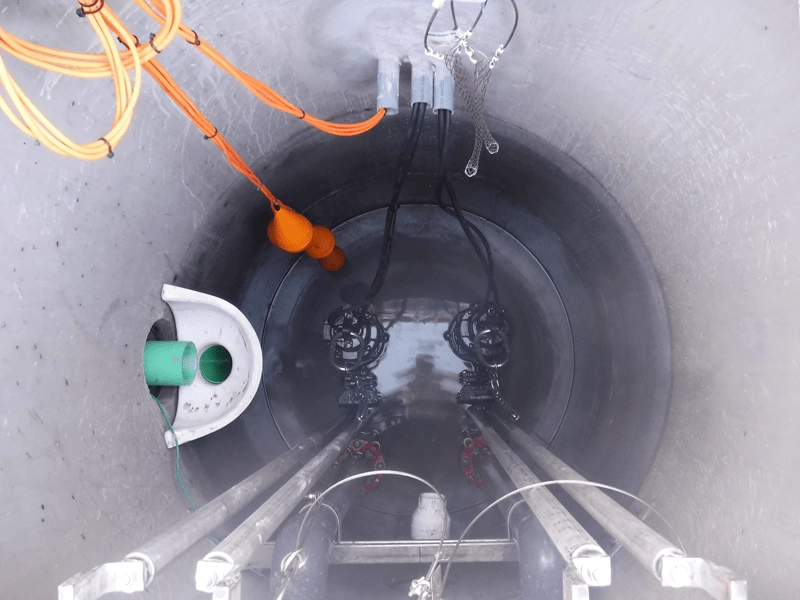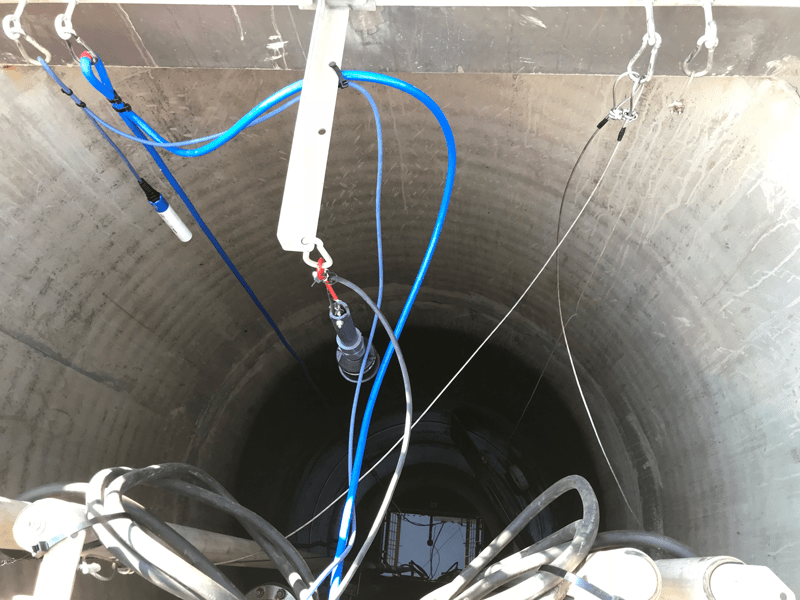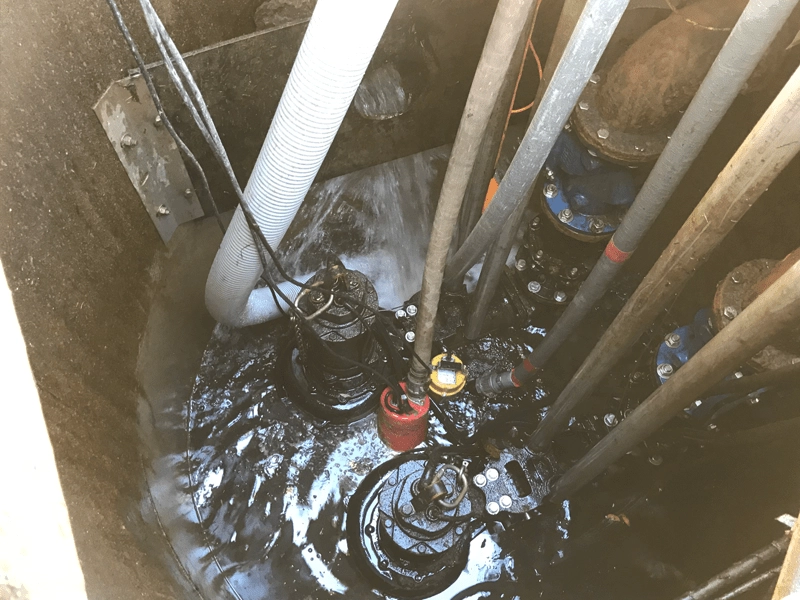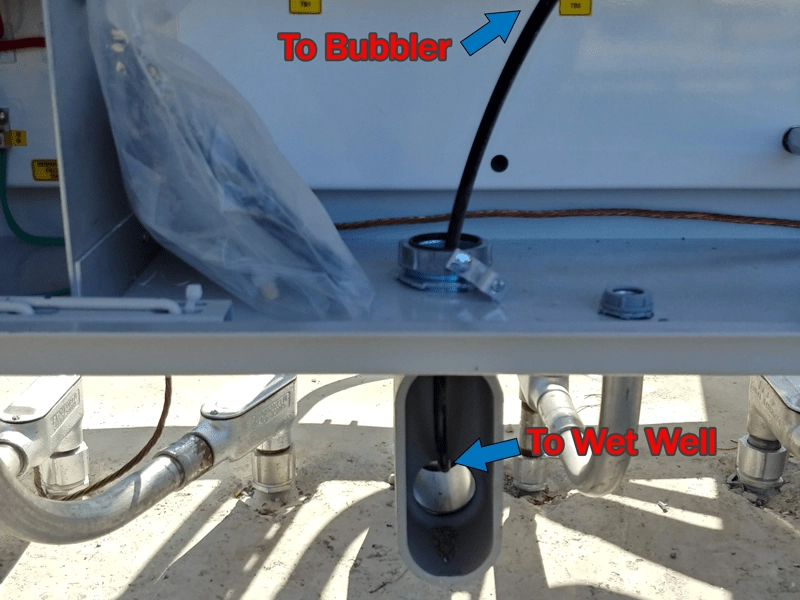Level Sensing Device Types and Their Application

Level sensing can be one of the most vital components during pump station engineering and is critical for the safety of the lift station and surrounding areas. Level sensors allow technicians to monitor the level of fluid in the wet well without having to open the top hatch and they send signals to the controller to initiate pump down cycles of the fluid.
Many operators and engineers have enthusiastic opinions about what level sensing technology works best, but Romtec Utilities recognizes each option’s strengths and weaknesses, and can evaluate what level sensor will work best in each system we design. Many lift stations incorporate the use of multiple or different types of level sensors, with one as a primary and one as a secondary.
Level sensors can range from simple and easy to understand, to complex and technical. Romtec offers a variety of level sensing options for both primary and secondary level sensors, such as floats, probes, and pressure transducers. The following are some of our findings.
Floats: Floats are a common level sensing option in both stormwater and wastewater lift stations because they are easy to understand and cost effective. Multiple floats are installed in a wet well at pre-determined depths, and the rising water level displaces the float and activates an internal switch. The flipping of these switches as the floats change orientation indicates the water level in the well and is an efficient and accurate way to monitor water levels.
There are multiple types of floats than can be implemented in a wet well, such as mechanical floats, magnetic floats, and even mercury floats. Mechanical floats can be the best performing floats and pose no environmental threat, while Mercury floats come with the lowest cost, but may not be allowed in many states because of environmental regulations and the danger that Mercury can pose.

Since floats interact directly with the content in the wet well, it is important that the correct float is supplied for the system. Floats can come in casings that are resistant to chemicals, such as a NOLTA MS1 Float that is resistant to household chemicals and wastes and is suitable for use in a wastewater environment. Floats, however, are not an ideal level sensor for environments with high concentrations of industrial chemicals or acids, solids, or turbulence.
Mechanical floats are widely used as a primary or a secondary level sensing in wet wells and are an easy way to monitor the water level inside the well. Quality floats will always have a place in the world of liquid level control and are an important facet of a lift station.
Conductive Probes: Probes are another form of level sensing that Romtec Utilities can provide in our lift stations. Probes are long, cylindrical devices installed vertically near the side wall of the sump, with metal bands around its length. As the water level in the well rises, the fluid makes contact with the metal bands, which pass a small electric current though the fluid to complete a circuit. While they use electricity to monitor fluid levels, probes can operate with an intrinsically safe barrier that uses such a small electrical current that there is no danger of combustion.
Probes cost more than floats, but provide a durable level sensing system. They are incredibly accurate and easy to install and maintain. However, they are sensitive to turbulence, and can only be used when the fluid in the well conducts electricity. They are also not recommended when the fluid is flammable or combustible, even with the intrinsically safe barrier.

Pressure Transducers: Unlike floats and probes, pressure transducers are unaffected by turbulence and other problems that impact other level sensors. Pressure transducers are mounted or hung just below the surface of the water, near the bottom of the sump, and use a diaphragm to measure the pressure of the liquid in the well. From this pressure, the transducer can assume and relay level information to the controller.
Pressure transducers are incredibly reliable and dependable and can be altered/programmed to fit the needs of our customer’s system. They are robust units that require minimal maintenance after initial programming and installation, however the programming of these level sensors can be complex. Different fluids and materials have their own unique properties and pressures, so a pressure transducer requires a site-specific configuration to account for specific gravity and content density.
Pressure transducers are complex technology that require accurate programming and installation to get accurate readings, but they are located at the bottom of the well and are a more robust option for level sensing. In the right hands, a pressure transducer is a great method for sensing level.
Often, a defining factor in level sensing is what is familiar to our customer. Romtec Utilities works with our customer to determine which level sensing technologies are the best for both the application and the owner who will be maintaining the system.

Bubblers: Bubbler level sensing is often referred to as “outdated” or even “obsolete” but with Romtec Utilities’ ability to completely design systems unique to the application, we are able to incorporate all equipment types. Level sensing and control configurations are driven by the preferences of the end owner and Bubblers are still used and preferred by owners all across the nation. Fundamentally, a bubbler is like a pressure transducer in that it is determining the level of the water based on the pressure of the water column above the “sensing” location within the wet well. While a pressure transducer incorporates the use of an internal diaphragm, a bubbler uses compressed air. The bubbler compressor and controller will be located within the control panel, while the discharge of the compressor will be plumbed to the base of the wet well. A small opening at the end of this discharge will allow the compressor to push air into the well. The bubbler controller will then determine the wet well depth based on the compressor’s difficulty in pushing air into the well. The overall benefit of a bubbler would be that the unit as a whole is removed from the process fluid.
Radar and Ultrasonic Transducers: While using different wave frequencies, both ultrasonic transducers (UT) and Radar measure wet well level via “Time of Flight”. In other words, the level sensing unit will be mounted above the process fluid (but still within the wet well) and where it then transmits a sound wave that travels to the surface of the water and then reflected back to the level sensing unit. The amount of time the sound wave travels is then used to convert the distance between the sensor, the floor, and the surface of the water into a wet well level. This type of level sensor is great for applications that involve process fluids with high temperatures or extreme pH levels and component exposure to the liquid should be limited.
The choice of the type of level sensing device, or which type is best, is a discussion that will never end. What’s best is to offer what someone has experience with or the type that’s best for the specific application. They all work and they can all be reliable. At Romtec, we use them all. We provide what’s best for the approach and what the customer wants and or what the owners want. The choice is ultimately theirs.

Comments 2
Hi Iam working on a project where the client wants a telemetry system to monitor 2 sewer pumps wit hard wire, software where they can monitor the power, pump level in the wet well and flow. If you can assist let me know what do I have to supply.
Regards
Shawn
Ph 1(868)394-7945
Author
Shawn,
Thank you for contacting Romtec Utilities! We will be in touch with you soon.
Sincerely,
Hannah